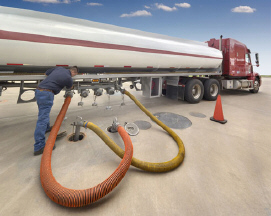True/False
Indicate whether the
statement is true or false.
|
|
|
1.
|
Your truck engine runs a pump used during delivery of compressed gas.
After you transfer the compressed gas, you should turn the engine off before you unhook the
hoses. 
|
|
|
2.
|
A “safe haven” is an approved place for parking unattended vehicles
loaded with explosives.
|
|
|
3.
|
If your placarded vehicle has dual tires, the tires must be checked before your
trip and every time you stop the truck to park.
|
|
|
4.
|
The power unit of a placarded vehicle must have a fire extinguisher with a UL
rating of 10 B:C or more.
|
|
|
5.
|
Placarded vehicles are NOT required to stop at railroad crossings.
|
Multiple Choice
Identify the
choice that best completes the statement or answers the question.
|
|
|
6.
|
If a vehicle is required to display a hazmat placard, the placards
must:
a. | Be on at least two sides. | b. | Be on the front and rear
only. | c. | Be only on the rear. | d. | Be on all four
sides. |
|
|
|
7.
|
Who is required to sign the certification on the shipping papers for hazardous
materials?
a. | Driver. | b. | Carrier. | c. | Shipper. | d. | Receiving
company. |
|
|
|
8.
|
A portable tank is defined as:
a. | A tank that has only two wheels. | b. | A tank that is not permanently attached to a
vehicle. | c. | A tank that is only used for hazmat cargo. | d. | None of the
above. |
|
|
|
9.
|
Who is responsible for safely transporting a hazardous material shipment and for
keeping shipping papers in the right place?
a. | Driver. | b. | Shipper. | c. | Carrier. | d. | Government. |
|
|
|
10.
|
If your placarded trailer has dual tires, how often must you check the
tires?
a. | Every hour. | b. | Every 500 miles. | c. | At the start of your
trip and each time you stop to park. | d. | When you cross any state
line. |
|